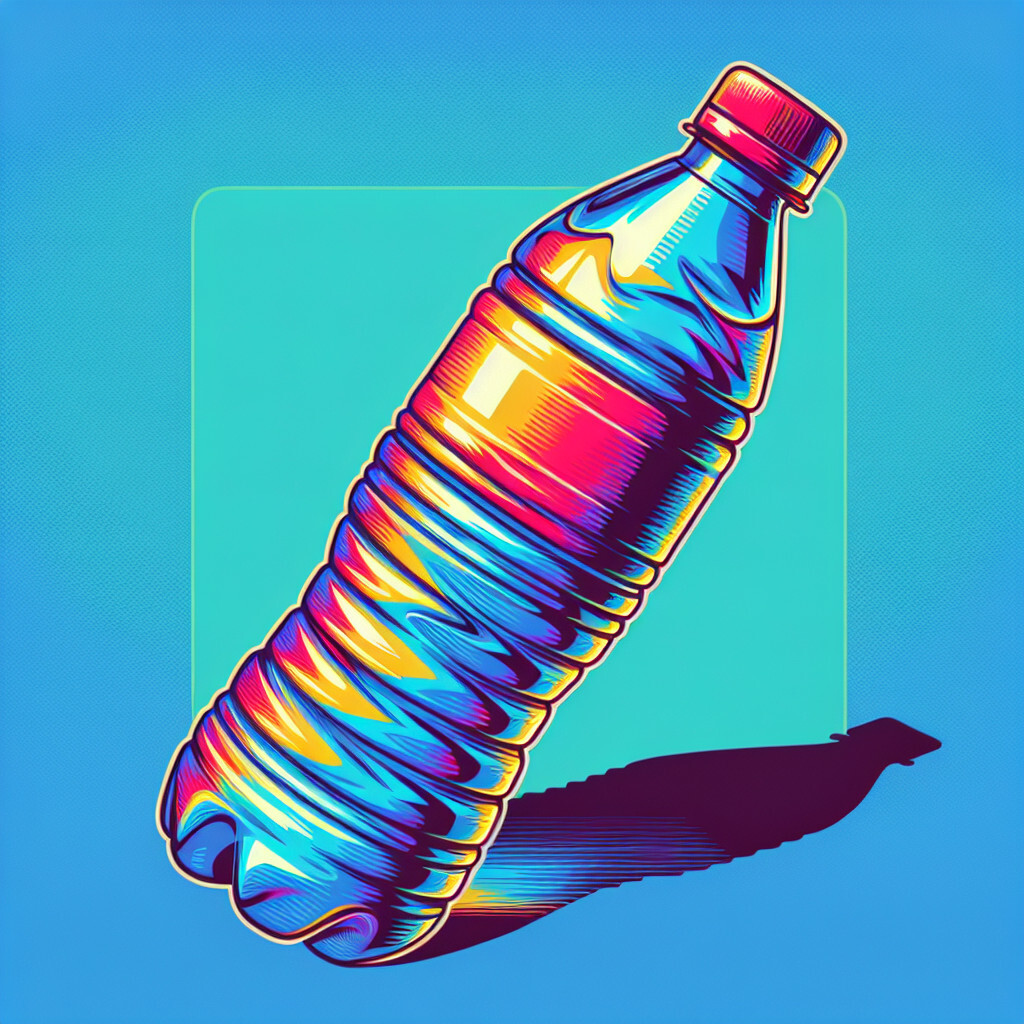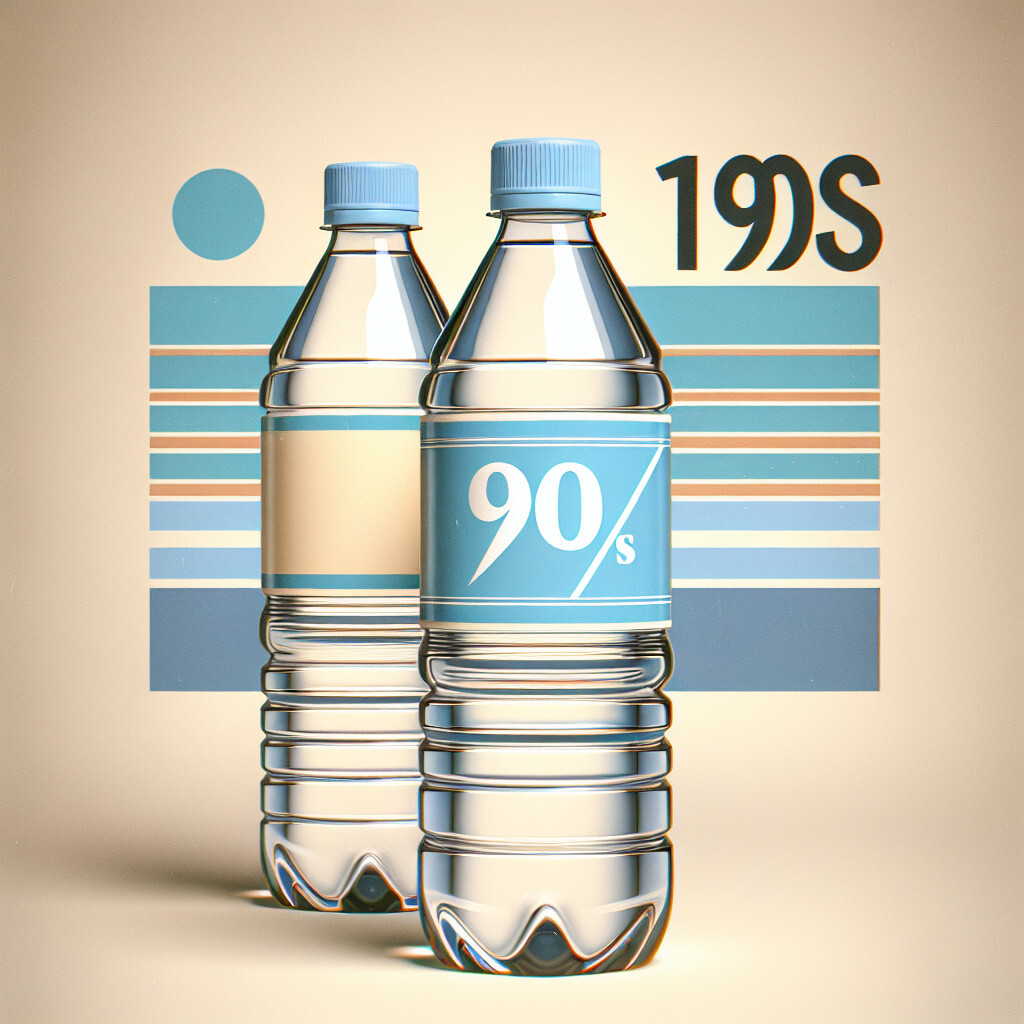-
Table of Contents
“Quenching the 90s Thirst: Pure, Crisp, Bottled Water”
Introduction

Bottled water in the 90s marked a significant shift in consumer behavior and market trends. During this decade, the bottled water industry experienced a boom, with many people starting to prefer it over tap water due to perceived health and safety benefits. Major brands like Evian, Perrier, and Dasani gained prominence, and the concept of water as a ‘luxury’ or ‘health’ product began to take root. The 90s also saw the introduction of more portable and convenient plastic bottles, which further fueled the popularity of bottled water. However, this period also marked the beginning of environmental concerns related to plastic waste, which continues to be a major issue today.
The Rise of Bottled Water Consumption in the 90s
The 1990s marked a significant shift in consumer behavior, particularly in the realm of beverage consumption. This decade witnessed the rise of bottled water as a popular choice among consumers, a trend that has continued to grow exponentially in the subsequent years. The bottled water industry, which was once considered a niche market, transformed into a multi-billion dollar industry during this period. This article aims to explore the factors that contributed to the surge in bottled water consumption in the 90s.
The 90s was a time of increased health consciousness among consumers. The decade saw a growing awareness about the importance of hydration and the role of water in maintaining good health. This was largely due to the efforts of health experts and fitness gurus who emphasized the need for regular water intake. Bottled water, being a convenient and portable option, became the go-to choice for many health-conscious individuals.
Moreover, the 90s was also a time when consumers started to question the safety and quality of tap water. Reports of water contamination and the presence of harmful chemicals in tap water led to a growing distrust among consumers. Bottled water was perceived as a safer and cleaner alternative, leading to an increase in its consumption.
Marketing strategies also played a crucial role in the rise of bottled water consumption in the 90s. Bottled water companies capitalized on the health and safety concerns of consumers and positioned their products as a premium, healthy, and safe choice. Advertisements featuring pristine natural springs and mountains were common, reinforcing the image of bottled water as pure and untouched.
Furthermore, the introduction of flavored and mineral-infused bottled water added a new dimension to the market. These products catered to consumers looking for variety and additional health benefits, further driving the demand for bottled water.
The 90s also saw the advent of the on-the-go lifestyle. With increasingly busy schedules, consumers sought convenience in their food and beverage choices. Bottled water fit perfectly into this lifestyle. It was easy to carry, could be consumed anywhere, and did not require any preparation. This convenience factor significantly contributed to the popularity of bottled water during this period.
The rise of bottled water consumption in the 90s was not without its critics. Environmentalists raised concerns about the impact of plastic bottles on the environment. However, these concerns were largely overshadowed by the perceived benefits of bottled water.
In conclusion, the rise of bottled water consumption in the 90s can be attributed to a combination of factors including increased health consciousness, concerns about the safety of tap water, effective marketing strategies, the introduction of flavored and mineral-infused water, and the convenience of bottled water. Despite the environmental concerns, the trend of bottled water consumption has continued to grow, making it a staple in the beverage industry. The 90s was indeed a pivotal decade that shaped the bottled water industry and set the stage for its future growth.
How 90s Marketing Strategies Shaped the Bottled Water Industry
The bottled water industry, as we know it today, owes much of its success to the marketing strategies of the 1990s. This was a pivotal decade that saw the transformation of bottled water from a luxury item to a commonplace commodity. The 90s marketing strategies not only shaped the bottled water industry but also significantly influenced consumer behavior and preferences.
In the early 90s, bottled water was considered a luxury product, consumed by a niche market of health-conscious individuals and travelers. However, the industry soon realized the untapped potential of the mass market. The challenge was to convince the average consumer, accustomed to drinking tap water, to pay for something they could essentially get for free. The solution lay in effective marketing strategies that capitalized on emerging health trends and environmental concerns.
One of the most successful marketing strategies was the promotion of bottled water as a healthier alternative to sugary soft drinks. In the 90s, there was a growing awareness of the negative health effects of high sugar consumption. Bottled water companies seized this opportunity to position their product as a healthy, calorie-free alternative. Advertisements emphasized the purity and naturalness of bottled water, often featuring images of pristine mountain springs and crystal-clear rivers. This strategy successfully tapped into the health-conscious market, driving a significant increase in bottled water consumption.
Simultaneously, bottled water companies also targeted the fitness industry. The 90s saw a boom in fitness and wellness trends, with more people hitting the gym and participating in sports activities. Bottled water was marketed as an essential part of the fitness regime, necessary for hydration and performance. This strategy effectively linked bottled water consumption with an active, healthy lifestyle, further boosting its appeal to the mass market.
Another significant marketing strategy was the use of environmental messaging. In the 90s, environmental consciousness was on the rise, and consumers were becoming more concerned about their impact on the planet. Bottled water companies responded by promoting their products as environmentally friendly. They highlighted their use of recyclable materials and their commitment to sustainable sourcing and production practices. This strategy appealed to the growing market of eco-conscious consumers, further driving the demand for bottled water.
However, it’s important to note that these marketing strategies were not without controversy. Critics argue that the bottled water industry exploited consumer fears and concerns for profit. They point out that the environmental impact of bottled water is far from benign, with millions of plastic bottles ending up in landfills each year. Furthermore, they contend that the health benefits of bottled water are often overstated, with many brands being no purer than tap water.
Despite these criticisms, there’s no denying the impact of 90s marketing strategies on the bottled water industry. They successfully transformed bottled water from a niche product into a mass-market commodity. Today, bottled water is a multi-billion dollar industry, with a global market that continues to grow. The strategies used in the 90s have not only shaped the industry but also set the stage for its future growth. They have established bottled water as a staple in our daily lives, a testament to the power of effective marketing.
Environmental Impact of Bottled Water in the 90s
The 1990s marked a significant shift in consumer behavior, with bottled water emerging as a popular choice for hydration. This trend was driven by a combination of factors, including clever marketing campaigns that touted the health benefits of bottled water, concerns about the safety of tap water, and the convenience of portable, disposable bottles. However, the environmental impact of this burgeoning industry was largely overlooked at the time, and it is only in retrospect that we can fully appreciate the magnitude of the problem.
The production of bottled water involves a complex process that begins with the extraction of water from natural sources. This process can have a detrimental effect on local ecosystems, as it often leads to the depletion of groundwater resources. In the 90s, the lack of stringent regulations allowed companies to extract water at unsustainable rates, leading to significant environmental damage. Moreover, the transportation of bottled water from the source to the consumer involves a considerable amount of energy, contributing to greenhouse gas emissions.
The packaging of bottled water also poses a significant environmental challenge. In the 90s, most bottled water was packaged in single-use plastic bottles, which are made from petroleum-based products. The production of these bottles requires a substantial amount of energy and results in the emission of harmful pollutants. Furthermore, the disposal of these bottles presents a major environmental problem. Despite the availability of recycling facilities, a large proportion of plastic bottles end up in landfills or, worse, in the oceans, where they contribute to the growing problem of plastic pollution.
The 90s also saw the rise of bottled water coolers in offices and homes, which further exacerbated the environmental impact of the bottled water industry. These coolers typically used large plastic jugs, which, while more efficient than single-use bottles, still contributed to plastic waste. Moreover, the energy required to cool the water added to the overall carbon footprint of the product.
In the 90s, the environmental impact of bottled water was largely ignored by consumers and regulators alike. The focus was on the perceived benefits of bottled water, such as its convenience and supposed purity. However, as we moved into the 21st century, the environmental consequences of this trend became increasingly apparent. Today, we are grappling with the legacy of the bottled water boom of the 90s, as we struggle to deal with the mountains of plastic waste and the depleted water resources left in its wake.
In conclusion, the bottled water trend of the 90s had a significant environmental impact, much of which is still being felt today. The extraction of water, the energy-intensive production and disposal of plastic bottles, and the greenhouse gas emissions associated with the transportation and cooling of bottled water all contribute to the environmental footprint of this industry. As we look back on this period, it serves as a stark reminder of the need for sustainable consumption practices and responsible corporate behavior. It is our responsibility to learn from the past and strive for a more sustainable future.
The Evolution of Bottled Water Brands from the 90s to Now
The bottled water industry has undergone a significant transformation since the 1990s. This evolution has been driven by a combination of factors, including changes in consumer preferences, advancements in technology, and shifts in marketing strategies. The journey from the 90s to the present day has seen bottled water brands evolve from a simple commodity to a lifestyle product, reflecting the changing dynamics of the beverage industry.
In the 1990s, bottled water was primarily seen as a convenient and safe alternative to tap water. Brands such as Evian, Perrier, and Poland Spring dominated the market, with their products being synonymous with purity and health. These brands capitalized on the growing health consciousness among consumers, positioning their products as a healthier alternative to sugary soft drinks. The packaging was simple and functional, with the focus being on the quality of the water rather than the aesthetics of the bottle.
However, as the new millennium dawned, the bottled water industry began to witness significant changes. Consumers started to demand more than just hydration from their beverages. They sought products that aligned with their lifestyle and values, leading to the emergence of new categories within the bottled water market. This shift in consumer preferences led to the introduction of enhanced waters, which were infused with vitamins, minerals, and other nutrients. Brands such as Vitamin Water and Smart Water gained popularity, offering consumers a value-added proposition.
Simultaneously, the bottled water industry also started to grapple with the growing concerns about its environmental impact. The use of plastic bottles became a contentious issue, leading to a backlash against bottled water brands. In response, many brands started to explore sustainable packaging solutions. Bottled water brands such as Fiji and Voss introduced water in glass bottles, while others like Boxed Water opted for carton-based packaging. These initiatives reflected the industry’s efforts to align with the increasing consumer demand for environmentally friendly products.
The rise of digital technology also had a profound impact on the bottled water industry. Social media platforms became a powerful tool for brands to engage with their consumers and build their brand identity. Bottled water brands started to focus on the aesthetics of their packaging, with the aim of making their products ‘Instagrammable’. Brands such as Evian collaborated with fashion designers to create limited edition bottles, while others like S’well introduced reusable water bottles in a variety of designs and colors.
Today, the bottled water industry is more diverse and dynamic than ever before. It caters to a wide range of consumer needs and preferences, from functional hydration to lifestyle alignment. Brands are continuously innovating, whether it’s in terms of product formulation, packaging design, or marketing strategies. The evolution of bottled water brands from the 90s to now is a testament to the industry’s ability to adapt and thrive in a changing market landscape.
In conclusion, the journey of bottled water brands from the 90s to the present day is a fascinating study of how an industry can evolve in response to changing consumer preferences, technological advancements, and environmental concerns. It is a journey that has seen bottled water transform from a simple commodity to a lifestyle product, reflecting the changing dynamics of the beverage industry. As we look to the future, it is clear that the bottled water industry will continue to innovate and adapt, ensuring that it remains relevant and responsive to the needs of the modern consumer.
Q&A
1. Question: What were some popular brands of bottled water in the 90s?
Answer: Some popular brands of bottled water in the 90s included Evian, Perrier, and Poland Spring.
2. Question: When did bottled water start to become popular?
Answer: Bottled water started to become popular in the late 1980s and its popularity significantly increased in the 1990s.
3. Question: Was bottled water considered environmentally friendly in the 90s?
Answer: In the 90s, the environmental impact of bottled water was not as widely discussed or understood as it is today. The focus was more on the perceived purity and health benefits of bottled water.
4. Question: What was the average cost of bottled water in the 90s?
Answer: The average cost of bottled water in the 90s varied by brand and location, but it was generally around $1 to $2 per liter.
Conclusion
In conclusion, bottled water in the 90s experienced a significant surge in popularity due to increased health consciousness, effective marketing strategies, and concerns about the safety of tap water. However, it also sparked debates about environmental impact and the commercialization of a basic human necessity.






